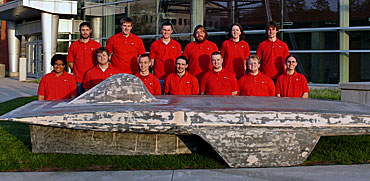 It’s still parts and pieces spread across a campus garage, but the tenth sun-powered race car designed and built by Iowa State University students is already looking super efficient.
It’s still parts and pieces spread across a campus garage, but the tenth sun-powered race car designed and built by Iowa State University students is already looking super efficient.
Just look at this, said Trevor Dobbs, a junior from Woodbury, Minn., as he picked up a shiny silver piece of the car’s suspension.
That suspension upright is “a very well engineered part,” said the materials engineering major and the assistant project director for Team PrISUm.
The uprights, which connect the upper and lower suspension arms to the wheel and axle assemblies, have six carefully hollowed sections through the middle. The idea is to shed as much weight as possible without sacrificing the strength of the part.
The same thinking has gone into just about every component of the two-year, $250,000 project, said Dobbs and mechanical engineering majors Evan Stumpges, a junior from Pauma Valley, Calif., and Shane Johnson, a senior from Panora, during a recent tour from part to part.
“Right now it’s a pretty great experience seeing all the parts we have been making coming together,” Dobbs said. “We’re very excited for the upcoming race. Every team has said this, but this is the best car we’ve ever built.”
The upcoming racing includes the Formula Sun Grand Prix, June 12-18 at the Motorsport Ranch in Cresson, Texas. That event is a testing and qualifying race for the American Solar Challenge, a June 19-26 race from Tulsa, Okla., to Chicago. Seventeen teams will compete, including 13 from the United States, two from Canada, one from Germany and one from Taiwan.
Team members like their new race car – named “Anthelion” after the rare luminous halo that sometimes appears opposite the sun – for a lot of reasons:
● They’ve taken the big step of switching from a four-wheeled car to a three-wheeler. Three wheels mean a lighter car because there are three sets of suspension assemblies instead of four. It means less rolling resistance on the road. It means the electric motor can be centered on the car, which improves balance and handling. And Johnson said it means a better aerodynamic shape and less wind resistance pushing against the car.
● They’ve shortened the aluminum tube chassis and found a way to fit the battery packs onto the car’s carbon fiber shell. The frame’s total weight is now less than 30 pounds. Stumpges said that’s about half the weight of the team’s previous frame.
● They’ve figured out how to use the super-light magnesium alloy wheels developed by a previous PrISUm team. The earlier team, however, had problems with the brittle alloy and problems mounting tires on the wheels. The current team has solved those problems with new, aluminum wheel mounts and a different finish on the wheels.
● The car’s 500-plus solar cells, battery protection system and electronics have been slightly revised to correct some glitches the 2008 team had to fix while on the road.
Dobbs said the team could go on and on about other “well thought-out systems” (thanks, in part, to extensive computer-aided design work).
But, he said, “It’s crunch time. And we definitely have a plan.”
The plan includes delivery of the last few parts. Final assembly. Sponsor logos on the trailer. Painting the car. Logistical planning. Rolling tests.
Then, after some long nights in their campus garage, it will be time for 1,100 miles of solar-powered, cross-country racing.
Contacts:
Trevor Dobbs, PrISUm Solar Car Team, (651) 230-5472, tjdobbs@iastate.edu
Evan Stumpges, PrISUm Solar Car Team, (515) 294-0899, stumpges@iastate.edu
Mike Krapfl, News Service, (515) 294-4917, mkrapfl@iastate.edu
Newswise also covered this story, as well as gizmag.
